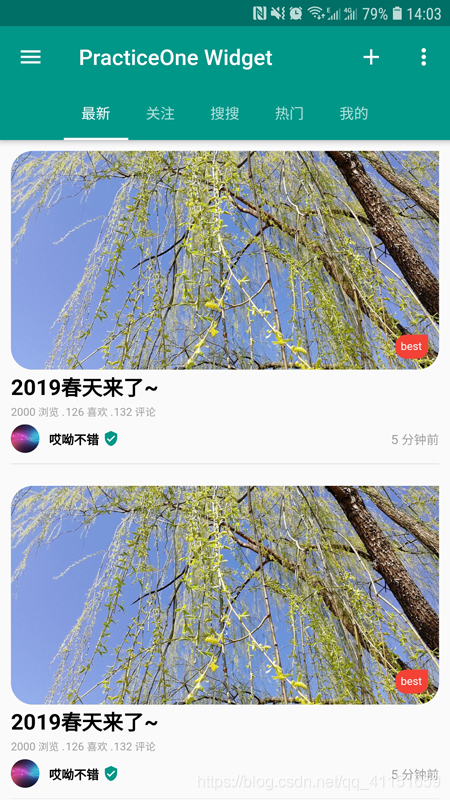前面已经讲解了一些常用的布局方式、常用 Widget 组件以及 Dart 语法。那么这节博客我们就来一个小总结,通过一个实例小页面来复习巩固我们之前学过的知识,理论结合实践。本课练习篇主要是完成两个完整的页面的编写,将会涉及到前面学习过的布局 Widget 和组件 Widget ,一起来学习吧,很简单!
以下的例子会涉及到: Scaffold、Container、Expand、Column、Row、AppBar、Text、Image、AlertDialog、Icon、RaisedButton、Form、TextFormField 等 Widget。
1.仿写 Instagram 列表页
效果图如下:

首先看下第一个例子页面,仿写一个 Instagram 列表页,我们主要是进行 Item 页面的绘制和顶部 Tab 页的效果绘制。我们这里可以使用 Scaffold 构建页面布局框架,然后使用 TabBar 实现顶部的 Tab 页效果。TabBar 的切换页面的 body 显示部分,使用 TabBarView 实现。
Item 的布局结构部分,我们通过效果图可以看出,外层可以使用Column纵向线性布局 Widget,图片圆角部分处理美化,使用 ClipRRect 和 BoxDecoration 进行圆角处理。
具体实现代码如下:
// 仿照Instagram列表页
import 'package:flutter/material.dart';
import 'package:flutter_samples/samples/practice_one_login.dart';
class PracticeOneSamples extends StatefulWidget {
@override
State<StatefulWidget> createState() {
return PracticeOneSamplesState();
}
}
class PracticeOneSamplesState extends State<PracticeOneSamples>
with SingleTickerProviderStateMixin {
TabController _tabController;
String imageUrl =
'https://gss0.bdstatic.com/94o3dSag_xI4khGkpoWK1HF6hhy/baike/c0%3Dbaike272%2C5%2C5%2C272%2C90/sign=eaad8629b0096b63951456026d5aec21/342ac65c103853431b19c6279d13b07ecb8088e6.jpg';
@override
void initState() {
super.initState();
_tabController = TabController(initialIndex: 0, length: 5, vsync: this);
}
@override
Widget build(BuildContext context) {
// 用Scaffold构建页面布局框架
return Scaffold(
// AppBar构建页面标题栏
appBar: AppBar(
title: Text('PracticeOne Widget'),
primary: true,
leading: IconButton(
icon: const Icon(Icons.menu),
onPressed: () {
Scaffold.of(context).openDrawer();
},
),
// 点击跳转页面
actions: <Widget>[
IconButton(
icon: Icon(Icons.add),
onPressed: () {
gotoPage();
}),
PopupMenuButton(
itemBuilder: (BuildContext context) => <PopupMenuItem<String>>[
PopupMenuItem<String>(
child: Text("热度"),
value: "hot",
),
PopupMenuItem<String>(
child: Text("最新"),
value: "new",
),
],
onSelected: (String action) {
switch (action) {
case "hot":
print("hot");
break;
case "new":
print("new");
break;
}
},
onCanceled: () {
print("onCanceled");
},
)
],
// 加入TabBar功能
bottom: TabBar(
controller: _tabController,
isScrollable: true,
tabs: <Widget>[
Tab(
text: "最新",
),
Tab(
text: "关注",
),
Tab(
text: "搜搜",
),
Tab(
text: "热门",
),
Tab(
text: "我的",
),
],
),
),
// 主体内容布局
body: TabBarView(
controller: _tabController,
children: <Widget>[
Center(
child: Column(
children: <Widget>[
getTabOne(),
getTabOne(),
],
),
),
Center(
child: Text("data2"),
),
Center(
child: Text("data3"),
),
Center(
child: Text("data4"),
),
Center(
child: Text("data5"),
),
],
),
);
}
// 主体内容布局
Widget getTabOne() {
return Padding(
// 四周加入内容页内边距
padding: EdgeInsets.only(top: 10,left: 10,right: 10,),
// 使用Column纵向线性布局
child: Column(
children: <Widget>[
// 对图片进行个性化圆角美化处理
ClipRRect(
// 使用Stack层叠布局实现右下角红色Tag标签角标
child: Stack(
alignment: Alignment.bottomRight,
children: <Widget>[
Image.network(
imageUrl,
fit: BoxFit.fitWidth,
width: MediaQuery.of(context).size.width,
height: 200,
),
// 右下角红色Tag标签角标
Container(
padding: EdgeInsets.all(5),
decoration: BoxDecoration(
color: Colors.red,
shape: BoxShape.rectangle,
borderRadius: BorderRadius.only(
topLeft: Radius.circular(10),
bottomLeft: Radius.circular(10),
bottomRight: Radius.circular(10)),
),
margin: EdgeInsets.all(10),
child: Text(
'best',
style: TextStyle(color: Colors.white, fontSize: 10),
),
)
],
),
// 个性化圆角处理
borderRadius: BorderRadius.only(
topLeft: Radius.circular(20),
bottomLeft: Radius.circular(20),
bottomRight: Radius.circular(20),
),
),
// 标题设置,居左居中
Container(
alignment: Alignment.centerLeft,
child: Text(
'2019春天来了~',
style: TextStyle(
color: Colors.black,
fontWeight: FontWeight.bold,
fontSize: 20),
),
),
// 用Row横向线性布局来实现数据展示
Row(
children: <Widget>[
Text(
'2000 浏览 .',
style: TextStyle(color: Colors.grey, fontSize: 10),
),
Text(
'126 喜欢 .',
style: TextStyle(color: Colors.grey, fontSize: 10),
),
Text(
'132 评论',
style: TextStyle(color: Colors.grey, fontSize: 10),
),
],
),
// 设置间隔
SizedBox(
height: 5,
),
Row(
children: <Widget>[
// 圆形头像
Container(
width: 26,
height: 26,
child: CircleAvatar(
backgroundImage: AssetImage("assets/assets_image.png"),
radius: 50.0,
),
),
// 昵称
Text(
' 哎呦不错 ',
style: TextStyle(
color: Colors.black,
fontWeight: FontWeight.bold,
fontSize: 12),
),
// 认证图标Icon
Icon(
Icons.verified_user,
size: 15,
color: Colors.teal,
),
// 用Expanded来实现发表时间居右显示,宽度占用横向剩余空间
Expanded(
child: Container(
alignment: Alignment.centerRight,
child: Text(
' 5 分钟前',
style: TextStyle(color: Colors.grey, fontSize: 12),
),
),
),
],
),
// 分隔线
Container(
margin: EdgeInsets.only(top: 10, bottom: 10),
width: MediaQuery.of(context).size.width,
height: 0.2,
color: Colors.grey,
)
],
),
);
}
// 页面跳转,跳转到登录页
void gotoPage() {
Navigator.push(context, MaterialPageRoute(builder: (context) {
return PracticeOneLoginSamples();
}));
}
}
2.仿写登录页
效果图如下:

登录页面主要由这几个元素构成:标题栏、用户名输入框、密码输入框、登录按钮等。 依然使用Scaffold来构建页面布局框架,由于是有多个输入框,为了方便这里外层用Form来包裹输入框相关Widget,用户名和密码输入框使用TextFormField Widget。然后设置好输入框相关的属性配置即可,使用RaisedButton来实现登录按钮。当我们点击RaisedButton登录时候,通过Form表单来获取输入的用户名和密码信息进行显示。
很简单,接下来看下登录页例子实例代码:
// 仿写登录页面
import 'package:flutter/material.dart';
class PracticeOneLoginSamples extends StatefulWidget {
@override
State<StatefulWidget> createState() {
return PracticeOneLoginSamplesState();
}
}
class PracticeOneLoginSamplesState extends State<PracticeOneLoginSamples> {
// 用于Form表单的状态管理控制
GlobalKey<FormState> _formKey = new GlobalKey<FormState>();
FormState _formState;
String _name;
String _password;
@override
void initState() {
super.initState();
}
@override
Widget build(BuildContext context) {
// 使用Scaffold来构建页面布局框架
return Scaffold(
// AppBar设置页面标题栏
appBar: AppBar(
title: Text('PracticeOne Login Samples'),
backgroundColor: Colors.teal,
primary: true),
// 主体内容,设置了页面内边距,当然后面可以用SafeArea
body: Padding(
padding: EdgeInsets.only(left: 20, right: 20, top: 60),
// 用Form表单来管理组件
child: Form(
key: _formKey,
child: Column(
children: <Widget>[
// 用户名输入框相关
Container(
// 用户名输入框底部分隔横线
decoration: BoxDecoration(
border: Border(
bottom: BorderSide(color: Colors.grey, width: 0.2)),
),
// 用户名输入框
child: TextFormField(
maxLines: 1,
keyboardType: TextInputType.emailAddress,
style: TextStyle(fontSize: 18),
// 光标颜色
cursorColor: Colors.grey,
// 保存
onSaved: (String value) {
_name = value;
},
// 验证
validator: (String value) {
return value.contains('@') ? null : '要使用邮箱格式';
},
// 装饰输入框相关属性配置
decoration: InputDecoration(
hintText: '请输入邮箱帐号...',
labelText: '用户名',
// 无边框
border: InputBorder.none,
// 前缀图标
prefixIcon: Icon(Icons.person)),
),
),
// 设置间隔
SizedBox(
height: 20,
),
// 密码输入框相关配置
Container(
decoration: BoxDecoration(
border: Border(
bottom: BorderSide(color: Colors.grey, width: 0.2)),
),
child: TextFormField(
obscureText: true,
cursorColor: Colors.grey,
maxLines: 1,
onSaved: (value) {
_password = value;
},
onFieldSubmitted: (value) {},
keyboardType: TextInputType.numberWithOptions(),
style: TextStyle(fontSize: 18),
// 装饰输入框相关属性配置
decoration: InputDecoration(
hintText: '请输入密码...',
labelText: '密码',
border: InputBorder.none,
// 前缀图标
prefixIcon: Icon(Icons.lock)),
),
),
// 设置间隔
SizedBox(
height: 30,
),
// 登录按钮
Container(
width: MediaQuery.of(context).size.width,
// 使用RaisedButton
child: RaisedButton(
padding: EdgeInsets.all(13),
// 圆角配置
shape: RoundedRectangleBorder(
borderRadius: BorderRadius.all(Radius.circular(6))),
color: Colors.teal[500],
child: Text(
"登录",
style: TextStyle(
color: Colors.white,
fontSize: 18,
),
),
// 登录按钮点击事件
onPressed: () {
showLogin(context);
},
),
)
],
),
),
),
);
}
// 登录按钮点击执行的方法
Future<void> showLogin(BuildContext context) async {
final _formState = _formKey.currentState;
// Form表单验证通过
if (_formState.validate()) {
// 调用save方法回调获取输入框内值
_formState.save();
// 弹出对话框AlerDialog
return showDialog<void>(
context: context,
// 点击周围空白区域对话框是否消失
barrierDismissible: false,
builder: (BuildContext context) {
// 弹出对话框AlerDialog
return AlertDialog(
title: Text("提示"),
content: new Text("用户名:'$_name' \n 密码:'$_password'"),
actions: <Widget>[
new FlatButton(
onPressed: () => Navigator.of(context).pop(false),
child: new Text("取消")),
new FlatButton(
onPressed: () {
Navigator.of(context).pop(true);
},
child: new Text("确定"))
],
);
});
}
}
}
3.总结
这样就实现了两个简单的页面,涵盖了我们前面所学习的Widget。相信通过这样一个综合小实例,大家可以对Flutter的页面绘制、应用开发有了一个更深入的了解。
也可以在这个Flutter案例网站进行学习和查看: https://itsallwidgets.com/
